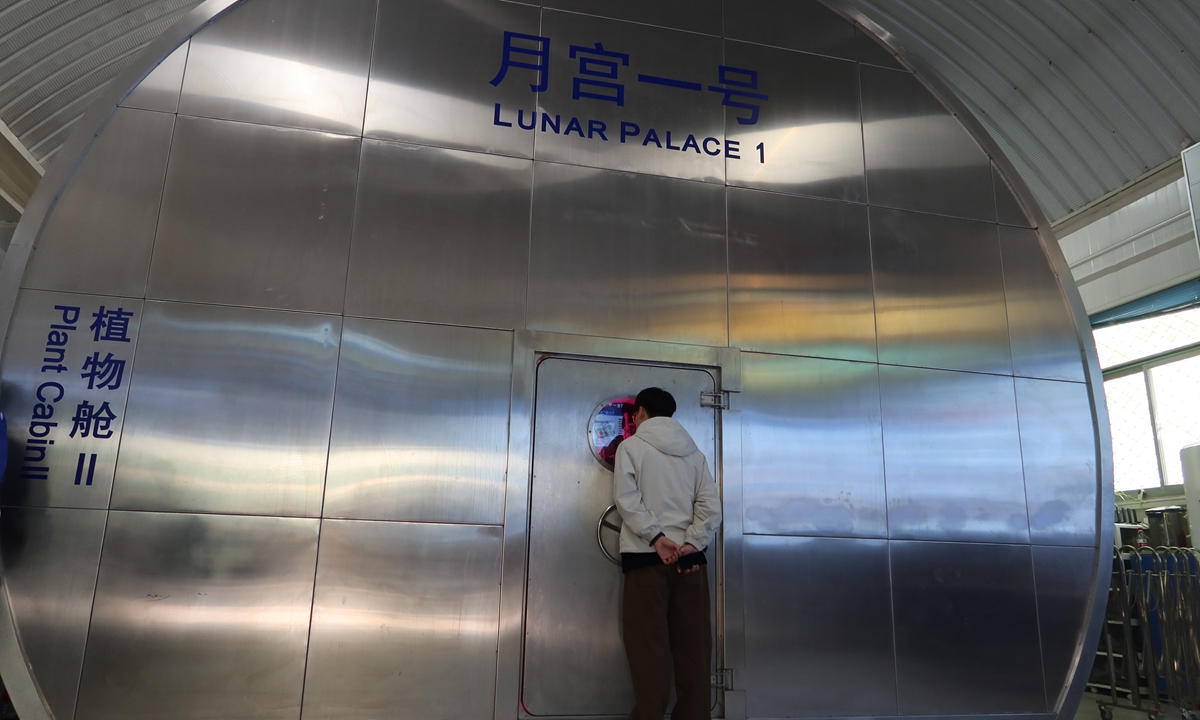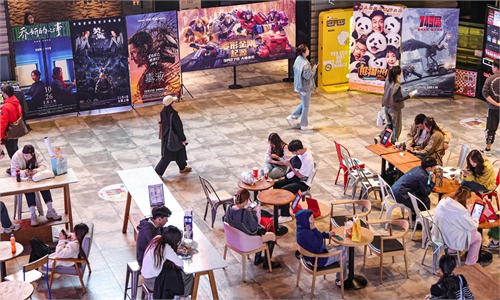ARTS / CULTURE & LEISURE
Space Day invigorates cosmic fever
Exhibitions to ignite youth interest in exploration

A man looks into the Plant Cabin II of the Lunar Palace 1, a research facility for developing moon exploration, at Beihang University on April 24, 2025, the 10th Space Day of China. Photo: IC
A space science exhibition opened in Shanghai on Thursday, China's annual Space Day, to celebrate the country's achievements in space exploration and promote public interest in space science and technology.A culture forum and school education campaign were also held to highlight the integration of space innovation with education and the arts.
As one of the main venue activities of the Space Day of China held in Shanghai, the exhibition showcases cutting-edge models and real artifacts in space technology, space science, space applications and commercial aerospace.
Running from Thursday through the upcoming May Day holiday to May 5 at the Shanghai World Expo Exhibition and Convention Center, the exhibition presents the public with its highlight display - the lunar soil samples collected from both the near and far sides of the Moon respectively by China's Chang'e-5 and Chang'e-6 missions.
The different color, density, and particle origins of the lunar soil is expected to spark the public's curiosity about the mysteries of the moon's evolution.
Other must-see exhibits included the actual return capsule of the Chang'e-5 mission, the national flag displayed on the lunar surface during the Chang'e-6 mission, models of Long March carrier rockets, a model of China's first solar exploration science and technology test satellite Xihe and the actual YF-100 engine, China's new-generation liquid rocket engine.
Apart from the artifacts and models, visitors can even hear the "sounds from Mars," which are deeper, quieter, and slower compared to those on Earth, the Paper reported.
The sounds were recorded by China's first Mars rover, Zhurong, after it landed on Mars in May 2021 and captured the first-ever audio recording on the surface of Mars in June 2021 through a sound sensor on the rover.
Besides the displays, the 2025 Space Culture and Art Forum, themed "Expressing Space Culture in a Diverse Way," was held in Shanghai on Wednesday.
Aimed at promoting the deep integration of space with culture, art, and science education, enriching aerospace cultural and artistic development, and inspiring the public to explore the unknown and embrace innovation, the forum brought together guests from the fields of space science and technology, cultural communication, artistic creation, media, and sports, according to the China National Space Administration (CNSA).
Tang Hongbo, a Chinese astronaut who has traveled to space twice aboard the Shenzhou spacecraft, talked about his experience of conducting an extravehicular mission to repair the solar wings of the core module of China's Tiangong Space Station at the forum.
Olympic diving champion Quan Hongchan shared the similarities between diving and space exploration, saying they both were about defying gravity in pursuit of perfection.
A six-episode documentary Missions to the Moon was also launched on Wednesday.
The series focuses on the Chang'e-6 mission of collecting lunar samples from the far side of the moon, while reflecting on the 20-year journey of China's lunar exploration.
For the first time, the film provides a comprehensive and systematic portrayal of the five core systems of China's lunar exploration program - the overall project, the probe, the launch and recovery system, deep-space tracking and control, and ground applications - showing the spirit of Chinese aerospace professionals by telling the little-known stories behind the nation's remarkable progress in space exploration.
Starting in 2016, China chose April 24 as the Space Day to mark the launch of its first satellite, Dongfanghong-1, into space on April 24, 1970.
The events to celebrate the Space Day aimed to inspire public support for space endeavors and cultivate scientific curiosity among young people, encouraging them to explore and innovate, Liu Yunfeng, deputy director of CNSA's system engineering department, said at a press conference last week.
To promote space education among young Chinese minds, leading aerospace research institutes and the China Space Museum launched a nationwide educational campaign in primary and junior high schools on Tuesday, featuring live-streamed science classes that explored the history of China's missile and rocket development.
More than 400,000 students at over 500 schools from 25 provincial-level regions joined the online classes.
Through these science popularization and cultural events, the public can learn more about the country's latest innovations and technological achievements, as well as aerospace professionals' spirit of perseverance in an accessible and engaging way, Pang Zhihao, a Beijing-based senior space expert, told the Global Times.
Besides traditional education events such as exhibitions and lectures, Pang suggested organizing more hands-on activities to attract young people, such as spacecraft model building, astronomical observations, and simulated space exploration missions.
Pang also recommended producing high-quality science videos and interactive educational games, as well as leveraging social media platforms to make aerospace content more accessible and appealing to young people.




